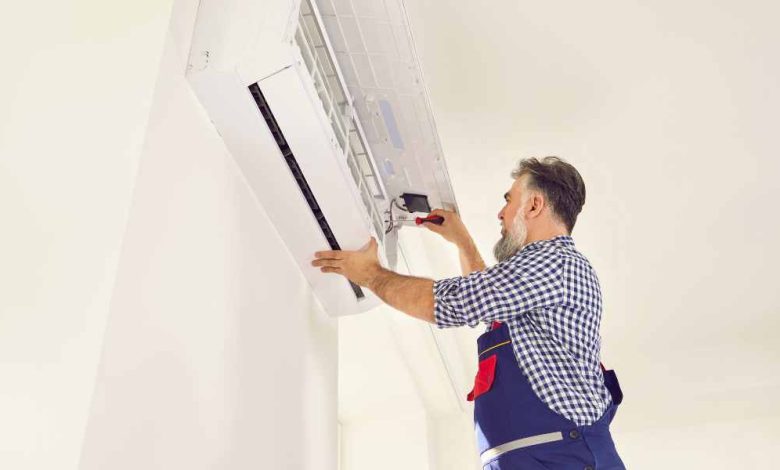How to Purge Air from an AC System: A Step-by-Step Guide
How to Purge Air from an AC System: A Step-by-Step Guide

Maintaining an efficient air conditioning (AC) system is essential for ensuring comfort, especially during hot summer months. One critical maintenance task is purging air from an AC system. Air trapped in your AC system can cause inefficiency, increase energy costs, and potentially lead to damage over time. In this guide, we’ll cover why it’s important to purge air from your AC system, the symptoms of air in your system, and a step-by-step process for how to do it.
Why Is It Important to Purge Air from Your AC System?
Air is an unwelcome guest in your AC system because it disrupts the proper circulation of refrigerant, which is essential for cooling. When air mixes with refrigerant, it can cause a range of issues, including:
- Reduced cooling efficiency: Air in the system prevents the refrigerant from effectively absorbing and transferring heat, resulting in warmer air being blown into your home.
- Increased energy consumption: Since the AC has to work harder to achieve the desired temperature, it consumes more electricity, leading to higher energy bills.
- Damage to system components: Air can create pressure imbalances, leading to wear and tear on components like the compressor, which can shorten the life of your AC unit.
- Ice buildup: The presence of air can cause the evaporator coil to freeze, leading to ice buildup and eventual damage.
Regularly purging air from your AC system ensures optimal performance, energy efficiency, and longevity of your unit.
Signs That There’s Air in Your AC System
Before you learn how to purge air from your AC system, it’s helpful to know the symptoms that indicate air is present. Some common signs include:
- Poor Cooling Performance: If your AC system is blowing warm or less cool air than expected, it might be a sign that air is trapped in the system.
- Unusual Noises: Hissing or bubbling sounds may indicate that air has entered the refrigerant lines.
- Higher Energy Bills: A sudden spike in your electricity bill could be a sign that your system is overworking due to air in the system.
- Ice on the Evaporator Coil: Air in the system can cause uneven cooling, which might result in ice forming on the evaporator coil.
- Inconsistent Temperature: If you notice uneven temperatures throughout your home, this could also be a sign of trapped air in the system.
Once you’ve identified these symptoms, it’s time to purge the air and restore your AC to optimal condition.
Tools and Equipment Needed
Before starting, gather the following tools and equipment for the task:
- Manifold gauge set
- Refrigerant recovery machine
- Vacuum pump
- AC refrigerant
- Adjustable wrench
- Safety goggles and gloves
Having the right tools ensures that you can complete the task safely and efficiently.
Step-by-Step Guide to Purging Air from an AC System
Step 1: Turn Off the Power
Before working on your AC system, safety should be your first priority. Turn off the power to the unit at the breaker box to prevent any accidents while you’re working on the system.
Step 2: Attach the Manifold Gauge Set
The manifold gauge set is used to measure the pressure in the AC system. Attach the hoses from the gauge set to the service ports on your AC unit. The blue hose should be connected to the low-pressure port, and the red hose should be attached to the high-pressure port.
Make sure the valves are closed before attaching the gauge set to avoid any leakage.
Step 3: Check the Pressure
Once the manifold gauge set is attached, check the pressure readings. If the pressure is higher than normal, it could indicate that there’s air trapped in the system. This is a key indicator that purging is necessary.
Step 4: Connect the Refrigerant Recovery Machine
The next step in purging air from your AC system is to recover the refrigerant. Connect the refrigerant recovery machine to the manifold gauge set, following the manufacturer’s instructions. The recovery machine will safely remove the refrigerant from the system, including any air mixed with it.
Step 5: Purge the System with a Vacuum Pump
After recovering the refrigerant, it’s time to use a vacuum pump to purge the air from the system. Connect the vacuum pump to the manifold gauge set and turn it on. The vacuum pump will remove any remaining air and moisture from the AC system. Let the pump run until the pressure on the gauge reads zero, indicating that all air has been removed.
This step is crucial because any remaining air or moisture can lead to inefficiency or damage over time.
Step 6: Recharge the AC System with Refrigerant
Once the air has been purged, it’s time to recharge the system with refrigerant. Follow the manufacturer’s instructions for your specific AC unit to add the appropriate amount of refrigerant. This step is important because undercharging or overcharging the system can lead to inefficiency or damage.
Attach the refrigerant supply to the manifold gauge set and slowly open the valve to allow the refrigerant to enter the system. Monitor the pressure readings on the gauge to ensure you’re adding the correct amount of refrigerant.
Step 7: Test the System
After recharging the system, turn the power back on and test the AC to ensure it’s working properly. Check for consistent cooling, listen for unusual sounds, and monitor the temperature to confirm that the air has been successfully purged from the system.
If everything is running smoothly, congratulations! You’ve successfully purged air from your AC system and restored its efficiency.
When to Call a Professional
While purging air from an AC system can be a DIY task for those with the right tools and experience, there are situations where it’s best to call a professional HVAC technician:
- Lack of experience: If you’re unfamiliar with AC systems or don’t have the right equipment, it’s best to leave the job to a professional to avoid causing damage.
- Refrigerant handling: Refrigerant is a hazardous material, and improper handling can be dangerous. Licensed professionals are trained to handle refrigerants safely and in compliance with environmental regulations.
- Complex issues: If purging the air doesn’t resolve the issue, or if you notice other problems with your AC system, a professional technician can diagnose and fix the underlying issue.
Preventing Air from Entering Your AC System
Once you’ve purged the air from your AC system, it’s important to take steps to prevent it from happening again. Here are some tips for keeping air out of your system:
- Regular Maintenance: Schedule regular maintenance for your AC system to ensure that it’s running efficiently and to catch any issues before they become serious.
- Seal Leaks: Ensure that there are no leaks in the refrigerant lines or other parts of the AC system, as these can allow air to enter.
- Proper Installation: If you’re installing a new AC unit, make sure it’s done by a qualified technician to prevent air from being trapped during installation.
Conclusion
Purging air from your AC system is a necessary step in maintaining its efficiency and performance. By following the steps outlined above, you can safely remove air from the system, recharge it with refrigerant, and keep your home cool and comfortable. If you’re unsure about any part of the process or don’t feel comfortable doing it yourself, don’t hesitate to call a professional HVAC technician. Regular maintenance and attention to your AC system will help prevent air from entering and keep your system running smoothly for years to come.




